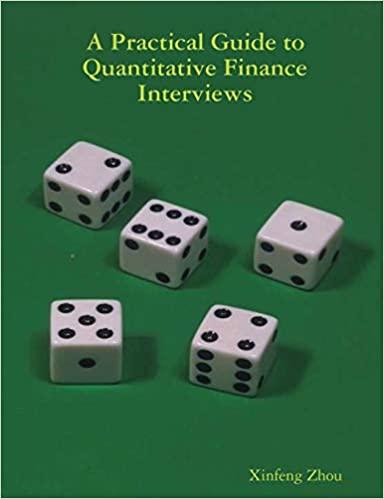Question
Assignment FIN 215 Introduction to Finance Total Marks 25 Instructions: a. The assignment need to be MS Word format Ques. 1 Using the data in
Assignment
FIN 215 Introduction to Finance
Total Marks 25
Instructions:
a. The assignment need to be MS Word format
Ques. 1 Using the data in the following table, estimate
the average return and volatility for each stock,
the covariance between the stocks, and
the correlation between these two stocks.
| year | 2004 | 2005 | 2006 | 2007 | 2008 | 2009 |
| Stock A | -10% | 20% | 5% | -5% | 2% | 9% |
| Stock B | 21% | 7% | 30% | -3% | -8% | 25% |
(3 marks)
Ques. 2 Suppose you have $100,000 in cash, and you decide to borrow another $15,000 at a 4% interest rate to invest in the stock market. You invest the entire $115,000 in a portfolio J with a 15% expected return and a 25% volatility.
What is the expected return and volatility (standard deviation) of your investment?
What is your realized return if J goes up 25% over the year?
What return do you realize if J falls by 20% over the year?
marks)
Ques. 3 Harrison Holdings, Inc. (HHI) is publicly traded, with a current share price of $32 per share. HHI has 20 million shares outstanding, as well as $64 million in debt. The founder of HHI, Harry Harrison, made his fortune in the fast food business. He sold off part of his fast-food empire, and purchased a professional hockey team. HHIs only assets are the hockey team, together with 50% of the outstanding shares of Harrys Hotdogs restaurant chain. Harrys Hotdogs (HDG) has a market capitalization of $850 million, and an enterprise value of $1.05 billion. After a little research, you find that the average asset beta of other fast-food restaurant chains is 0.75. You also find that the debt of HHI and HDG is highly rated, and so you decide to estimate the beta of both firms debt as zero. Finally, you do a regression analysis on HHIs historical stock returns in comparison to the S&P 500, and estimate an equity beta of 1.33. Given this information, estimate the beta of HHIs investment in the hockey team.
marks)
Ques. 4 You own a firm with a single new product that is about to be introduced to the public for the first time. Your marketing analysis suggests that the demand for this product could be anywhere between 500,000 units and 5,000,000 units. Given such a wide range, discuss the safest cost structure alternative for your firm
marks)
Ques. 5 One year ago, your company purchased a machine used in manufacturing for $110,000. You have learned that a new machine is available that offers many advantages; you can purchase it for $150,000 today. It will be depreciated on a straight-line basis over 10 years, after which it has no salvage value. You expect that the new machine will produce EBITDA (earning before interest, taxes, depreciation, and amortization) of $40,000 per year for the next 10 years. The current machine is expected to produce EBITDA of $20,000 per year. The current machine is being depreciated on a straight-line basis over a useful life of 11 years, after which it will have no salvage value, so depreciation expense for the current machine is $10,000 per year. All other expenses of the two machines are identical. The market value today of the current machine is $50,000. Your companys tax rate is 45%, and the opportunity cost of capital for this type of equipment is 10%. Is it profitable to replace the year-old machine?
marks)
Ques. 6 Chips Home Brew Whiskey forecasts that if the firm sells each bottle of Snake-Bite for $20, then the demand for the product will be 15,000 bottles per year, whereas sales will be 90 percent as high if the price is raised 10 percent. Chips variable cost per bottle is $10, and the total fixed cash cost for the year is $100,000. Depreciation and amortization charges are $20,000, and the firm has a 30 percent marginal tax rate. Management anticipates an increased working capital need of $3,000 for the year. What will be the effect of a price increase on the firms FCF for the year?
(3 marks)
Ques 7. Calculate the weighted average cost of capital for a firm, explain the limitations of using a firms weighted average cost of capital as the discount rate when evaluating a project, and discuss the alternatives to the firms weighted average cost of capital that are available.
(3 marks)
Step by Step Solution
There are 3 Steps involved in it
Step: 1

Get Instant Access to Expert-Tailored Solutions
See step-by-step solutions with expert insights and AI powered tools for academic success
Step: 2

Step: 3

Ace Your Homework with AI
Get the answers you need in no time with our AI-driven, step-by-step assistance
Get Started


